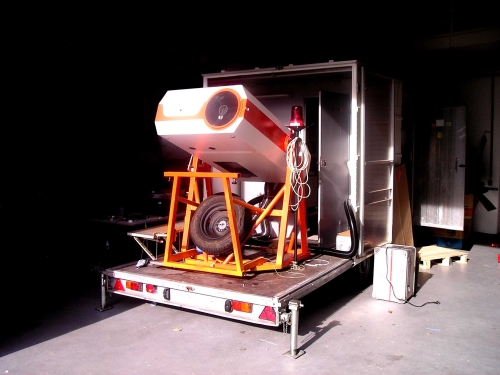Aerosol Lidar
Stationary Aerosol Lidar (NDACC Lidar)
The stationary aerosol lidar was developed in 1973 by Walter Carnuth in co-operation with Impulsphysik (Hamburg). The originally used 1-J ruby laser is meanwhile replaced by a 1.4 J, 10 Hz Nd:YAG laser (Quanta Ray, GCR 4), operated at 532 nm and, optionally, at 355 nm. The receiver is based on a 0.52-m-diameter Cassegrain telescope. The system is optimized for measurements between 2 km a.s.l. and more than 60 km. The stratospheric measurements require single-photon counting and are, therefore, carried out during nighttime. The system was upgraded in 1991 for high-resolution scanning of contrails (see picture). An optional depolarization channel was added for distinguishing ice cristals and background aerosol. The system is part of the NDACC.

NDACC lidar in front of IMK-IFU, on a day with pronounced contrail formation.
Mobile Three-wavelength-Aerosol lidar (High-Spectral-Resolution Lidar)
The mobile three-wavelength aerosol lidar (see figure below) is the second oldest lidar system of IMK-IFU (Impulsphysik, 1978). In its current version, used for the mid- and lower-tropospheric studies within EARLINET ![]() , the lidar wavelengths 355 nm, 532 nm and 1064 nm are provided by a single-mode Nd:YAG laser (Quanta Ray, Lab 150, 0.6 J per pulse, repetition rate 30 Hz). The lidar was recently upgraded by adding a high-spectral-resolution channel at 532 nm. In this channel the spectrally narrow aerosol component in the backscattered light is removed by filtering the light in an iodine absorption cell. As a consequence, the aerosol extinction coefficients may be retrieved independently from the backscatter coefficients. This method is based on Rayleigh backscattering and, thus, allows daytime extinction measurements, which are seriously impeded by the strong solar background in the most commonly used, but substantially less sensitive Raman lidar technique.
, the lidar wavelengths 355 nm, 532 nm and 1064 nm are provided by a single-mode Nd:YAG laser (Quanta Ray, Lab 150, 0.6 J per pulse, repetition rate 30 Hz). The lidar was recently upgraded by adding a high-spectral-resolution channel at 532 nm. In this channel the spectrally narrow aerosol component in the backscattered light is removed by filtering the light in an iodine absorption cell. As a consequence, the aerosol extinction coefficients may be retrieved independently from the backscatter coefficients. This method is based on Rayleigh backscattering and, thus, allows daytime extinction measurements, which are seriously impeded by the strong solar background in the most commonly used, but substantially less sensitive Raman lidar technique.
The lidar system is integrated in an air-conditioned box, mounted on the rear part of a trailer. The box can be rotated by 90º in elevation and by +/-90º in azimuth. One half of the box contains the laser and the harmonic generator, the other one the 0.3-m-diameter Cassegrain telescope and the four detection channels.

Three-wavelength aerosol lidar of IMK-IFU; the top of the lidar trailer is rolled forward in order to uncover the lidar system.
